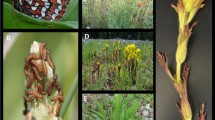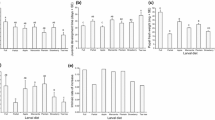Summary
The interactions between the checkerspot butterfly, Euphydryas chalcedona, and two of its principal host plants, Diplacus aurantiacus and Scrophularia californica, were studied to test the hypothesis that feeding behavior in nature reflects food quality in terms of leaf nitrogen and defensive chemical contents. Larvae preferentially fed on Diplacus leaves containing the highest nitrogen: resin ratio in the field and laboratory. Larvae did not feed selectively among Scrophularia leaves, which show little variation in quality. Seasonal timing of feeding activity and larval development rates were closely related to the availability of any Scrophularia leaves and high-quality Diplacus leaves.
Similar content being viewed by others
References
Andrewartha HG, Birch LG (1954) The Distribution and Abundance of Animals. University of Chicago Press. 782 p
Berenbaum M (1980) Adaptive significance of midgut pH in larval Lepidoptera. Amer Nat 115:138–146
Brown IL (1971) The population biology of Euphydryas chalcedona. Ph D dissertation. Stanford University
Brown IL, Ehrlich PR (1981) Population biology of the checkerspot butterfly, Euphydryas chalcedona. Structure of the Jasper Ridge colony. Oecologia (Berl) 47:239–251
Feeny P (1969) Inhibitory effects of oak leaf tannins on the hydrolysis of proteins by trypsin. Phytochemistry 8:2119–2126
Feeny P (1970) Seasonal changes in oak leaf tannins and nutrients as a course of spring feeding by winter moth caterpillars. Ecology 51:565–581
Issac RA, Johnson WC (1976) Determination of total nitrogen in plant tissue using a block digestor. J Asso Off Anal Chem 59:98–100
Lincoln DE (1980) Leaf resin flavonoids of Diplacus aurantiacus. Biochem Syst and Ecology 8:397–400
Lincoln DE, Langenheim JH (1978) Effect of light and temperature on monoterpenoid yield and composition in Satureja douglasii. Biochem Syst and Ecology 6:21–32
Lincoln DE, Newton T, Ehrlich PR, Williams KS (1982) Coevolution of the checkerspot butterfly Euphydryas chalcedona and its larval food plant Diplacus aurantiacus: Larval response to protein and leaf resin. Oecologia (Berl) 52:216–223
Mooney HA, Ehrlich PR, Lincoln DE, Williams KS (1980) Environmental controls on the seasonality of a drought deciduous shrub, Diplacus aurantiacus and its predator, the checkerspot butterfly, Euphydryas chalcedona. Oecologia (Berl) 45:143–146
Mooney HA, Williams KS, Lincoln DE, Ehrlich PR (1981) Temporal and spatial variability in the interaction between the checkerspot butterfly, Euphydryas chalcedona and its principal food source, the California shrub, Diplacus aurantiacus. Oecologia (Berl) 50:195–198
Munz PA (1959) A California flora. Berkeley, University of California Press 1681 p
Owen DF (1971) Tropical butterflies. Oxford, Clarendon Press 214 p
Rausher MD (1981) Host plant selection by Battus philenor butterflies — the roles of predation, nutrition, and plant chemistry. Ecol Monogr 51:1–20
Rhoades DF (1977) Integrated antiherbivore, antidesiccant and ultraviolet screening properties of creosotebush resin. Biochemical Systematics and Ecology 5:281–290
Rhoades DF, Cates RG (1976) Toward a general theory of plant antiherbivore chemistry. In Biochemical interactions between plants and insects. Wallace JW, Mansell RL, (eds) pp 168–213
Scriber JM (1977) Limiting effects of low leaf-water content on the nitrogen utilization, energy budget, and larval growth of Hyalophora cecropia (Lepidoptera: Saturniiadae). Oecologia (Berl) 28:269–287
Scriber JM, Slansky F (1981) The nutritional ecology of immature insects. Ann Rev Entomol 26:183–211
Williams KS (1981) The coevolution of the checkerspot butterfly, Euphydryas chalcedona, and its larval host plants. Ph D dissertation. Stanford University
Williams KS (1983) The coevolution of Euphydryas chalcedona butterflies and their larval host plants. III. Oviposition behavior and host plant quality. Oecologia (Berlin) 56:336–340
Williams KS, Lincoln DE, Ehrlich PR (1983) The coevolution of Euphydryas chalcedona butterflies and their larval host plants II. Maternal and host plant effects on larval growth, development, and food use efficiency. Oecologia (Berlin) 56:330–335
Author information
Authors and Affiliations
Rights and permissions
About this article
Cite this article
Williams, K.S., Lincoln, D.E. & Ehrlich, P.R. The coevolution of Euphydryas chalcedona butterflies and their larval host plants. Oecologia 56, 323–329 (1983). https://doi.org/10.1007/BF00379707
Received:
Issue Date:
DOI: https://doi.org/10.1007/BF00379707




